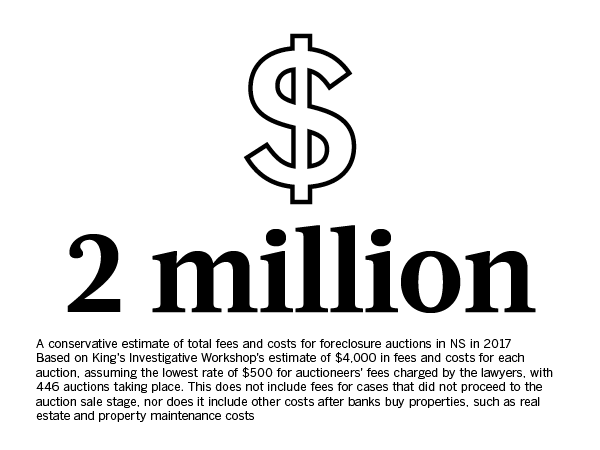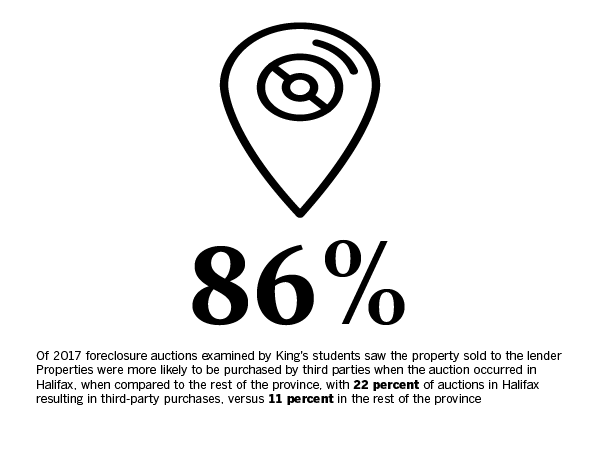
Up on the third floor of The Law Courts building in Halifax, down a long corridor from the elevator, is Room 314. It’s an unremarkable space, across the hall from one of the courtrooms. There are a couple of cheap office desks, a few mismatched chairs and an old green filing cabinet in the corner. A window looks out over a courtyard toward Upper Water Street.
It’s 9:30 in the morning in early February.
Two lawyers are seated at the desks, having a chat about the family history site ancestry.ca. The sound of a flushing toilet is heard from the washroom next door.
No one else is here except a King’s journalism student. Soon enough, one of the lawyers hands the other a cheque—it’s already filled out.
It has the feeling of a quick business meeting, but this was actually a public auction of a foreclosed property. The owner of a house in Fall River had fallen behind on their mortgage payments and the bank took them to court.
Both of the lawyers practice foreclosure law in Nova Scotia. One was acting as the court-appointed auctioneer. The other was the one and only bidder, representing the bank.
In just a few minutes, the deal is done and the Fall River couple has lost their home. The lawyers pack up their briefcases and leave Room 314. They’ve done this many times.
The primary purpose of any foreclosure process is to allow banks to recover the money they have lent through mortgage loans when borrowers don’t live up to the terms of the loan.
An investigation by journalism students at the University of King's College has found the Nova Scotia foreclosure system relies on the 18th-century idea of publicly auctioning properties of those who have fallen behind in mortgage payments but in reality, rarely obtains anything like real market value for the property.
Instead of being able to simply sell a property in the normal real estate market, lenders have to take borrowers to court to obtain an order that the property be sold by the court. It’s a process that runs up thousands of dollars in lawyers’ fees and expenses, all to be borne by the borrower, by the time the sale is scheduled. The end result is most often auctions where the bank or lender ends up buying the property, and then has to spend even more to resell it in the normal market.
King’s students built a database tracking about 500 foreclosure auctions advertised in 2017, through the court process and on to the final sale of the property. Their analysis found that the foreclosing lender purchased the property at auction more than eight times out of 10 at the 446 auctions public records show went ahead.
When the lender buys, no matter whether there were other bidders or it is the only bidder, it gets the property for that minimum bid amount, which covers just the cost of the auction itself and any outstanding property taxes.
This results in seemingly absurd outcomes such as a 6,000-square-foot home in Chester, assessed for taxes at nearly $1.2 million, selling at an auction in Bridgewater for $5,495.45.
More than 20 years ago, the Law Reform Commission of Nova Scotia recommended the province move to a simpler power of sale process that saves costs and time and returns any excess funds to borrowers, but elected officials failed to act. So the system keeps on going through the motions of selling properties through auctions, even though few bidders actually show up.
“Thirty, 40 years ago, foreclosure sales were held by the sheriff for Halifax in his office...It was huge and the office would often be packed with people there for a sale, and there’d be a real auction,” says Gerald Moir, a Nova Scotia Supreme Court judge who heads up the court’s foreclosure committee. But today, “These are not generating real auctions anymore.”

At one auction at The Law Courts, witnessed by King’s students in late February, there were two bidders: The bank’s lawyer, Ian Brown, and one third-party bidder. The bidding went back and forth until Brown stopped at $165,000, about $8,000 more than was owed to the bank according to the court’s order for foreclosure and sale. The property sold to the man for $165,500, who paid the deposit with $100 bills he’d brought in a brown envelope.
Unlike the bank—who even if they bid the third party up to a certain amount, only pays the minimum amount if the third party bows out—third-party bidders pay the actual amount they bid.
In another case in early 2017, a house in Deep Brook, between Annapolis Royal and Digby, was sold at a foreclosure auction in Annapolis Royal for $60,000, considerably less than the nearly $100,000 owed. The owner, Beverley Mosher, says she tried without success to sell the house before the bank foreclosed and the auction price still grates her to this day.
“To me, they gave it away,” says Mosher.
Only when there are multiple, competitive bidders is the price pushed much higher than the lender’s pre-determined maximum bid.
Before a property gets to a public auction, there has been a court process that has lasted weeks, with evidence presented by the lender’s lawyer and a hearing before a Supreme Court judge.
The cash-strapped borrower is usually unrepresented, and there is generally no valid defense to the suit.
Once the court issues an order for foreclosure and sale the auction is scheduled, the two notices are printed and one of the other foreclosure lawyers—one who doesn’t ever act for the lender that is owed money—runs the sale. The only bidder who is guaranteed to show up is the lender’s lawyer.
The bank buys most of the time
In the most common scenario, in which the bank buys, the borrower is quickly left on the sidelines.
Because the lender pays the minimum price of the auctioneer’s fee plus property taxes, the sale never generates enough money to pay off the debt. Even so, it has the same legal weight as a sale at a much higher price—the court still regards the auction as validly extinguishing the foreclosed property owner’s rights to the property.
If the bank resells for a profit, it is not accountable to the borrower for that money.
Philip Girard sees a problem with that. Girard is a noted legal historian who did research for the law reform commission’s study on foreclosures in the late ’90s. Today, he is a faculty member at the Osgoode Hall Law School in Toronto.
While the analysis of foreclosure sales by King’s students found that most of the time, lender resales don’t produce enough to pay off the debt and foreclosure costs, public records suggest there is a profit in a small minority of cases.
In about six percent of resales, the lender would likely have made money, even accounting for a six percent real estate commission and $10,000 in costs for the court case, auction and property management fees.
In two percent, the potential profit was in the tens of thousands.
Girard thinks such surplus value should go to the borrower.
“So, I think in the lender’s own mind, this all kind of evens out in the end…but that’s not really fair from the point of view of the individual borrower,” he says.
“If the individual borrower would have got a surplus out of it, and some surplus would have been returned to them, then it should be returned to them. It’s just as simple as that.”
But those involved in Nova Scotia’s system say that’s not how it works.
“My understanding of the law is that the lender is entitled to keep that money, the same as any other homeowner,” says Stephen Kingston, one of the longest-serving foreclosure lawyers in Nova Scotia.
And Moir says, “The (lender) is a speculator at that point. If you go and buy the property at the auction and you buy it for $20,000 and then you sell it for $30,000, you’ve made a $10,000 profit,” Moir says. “Should you have to pay that surplus to somebody else? Same thing for a mortgage company.”
While the borrower has no right to any profit after a resale, if the resale doesn’t generate enough to cover the debt and costs, the bank can ask the court to determine how much the borrower still owes, and in theory can pursue that “deficiency” for up to 20 years. In reality, banks sometimes don’t pursue deficiencies, and even when they do, borrowers may not be able to pay, or may go bankrupt and be discharged of the debt anyway.
Justice Moir says "nine out of 10 deficiency judgment applications are a waste of money."
All this contrasts with the simpler power of sale system used in Ontario. It allows deficiencies, but once debts and costs are paid off, any money left over from the sale goes back to the property owner, by law.
A small chance for the borrower
The only time the borrower has any right to excess proceeds in a foreclosure is if the property sells at the auction sale for more than what is owed the bank and the costs of the court process.
The trouble is, with relatively few bidders, there’s little impetus for the price to be pushed up for the benefit of the borrower.
Third-party buyers know the bank will stop bidding at a price not much higher than what it is owed. Those properties worth considerably more than what is owed become attractive because buyers can turn a profit on the difference between what they have to bid to get the property, and what they can resell it for.
Brian DeCoste looks for properties worth at least $50,000 more than the amount owed to the lender, to account for possible repairs and the time he may have to hold it. How much the lender is owed is in the order for foreclosure and sale, a public document, and a property’s value can be estimated from the assessed value for taxes, which is supposed to reflect market prices.
Andrew MacRae of Dartmouth, another repeat bidder, uses a similar strategy, looking for properties with older mortgages that likely have more paid off, and in the cases of borrowers in bankruptcy, looking up what they owe in public records.
“So you know exactly what you have to bid,” he says.
“The only chance of [the borrower] getting something back is if there is a bidding war at the auction, where two people want it, and it gets bid above what the foreclosed amount was,” MacRae adds.
In cases where there are excess funds, any surplus will be paid into the court, and the borrower, at least theoretically, can ask the court for it, once anyone else with an interest in the property, such as another creditor or second mortgage company, has been paid out.
The King’s investigation found such surpluses are rare, and borrowers getting any piece of such a surplus is even rarer.
After the auction
King’s students found that in a little more than half of the third-party purchases at auctions advertised in 2017, the winning bid was not enough to cover the debt owed by the borrower plus around $5,000 in costs for the foreclosure process (an estimate based on a review of court files, of legal and auctioneer fees, plus costs).
The students scoured detailed court files in Halifax and Kentville and found six files in which there was money left over after other creditors were paid, sitting at the courthouse unclaimed.
After five years, unclaimed surpluses from foreclosures go to the provincial treasury, though someone can still make a claim for them. In 2016, a modest $4,025 in unclaimed surpluses from foreclosure sales went to the province, but in 2017 $174,197 was transferred.
One possible reason why the money stays at the courthouse unclaimed is that borrowers don’t know it’s there. But Moir says they should have been informed by the lenders’ lawyers.
“….The rule says that the surplus stands in the place of the equity [the excess of the property’s value over what is owed] and has to be distributed according to the order of people who have an interest in the equity. And that would include the borrower,” he says.
A court spokesperson said Moir followed up with the lawyers on cases identified during the interview for this story.
Another explanation for unclaimed surpluses is borrowers may not bother pursuing the funds because getting them requires spending money, something you don’t have when your property is being foreclosed.
“If you’re going to hire a lawyer to make that application for you, it’s probably going to cost you a couple of thousand bucks, and do people have that ready cash to spend to try to get whatever amount of money back,” says Stephen Kingston, one of the longest-serving foreclosure lawyers in Nova Scotia. “And how does that compare with [the amount being held by the] court?”
Indeed, days of searching through court files turned up only one instance in which the file showed a borrower had actually taken the step of asking for the surplus, and getting the money.
Power of sale
Given that there are few valid defenses to a foreclosure lawsuit, and the only real way to stop the process is to make an arrangement with the bank to pay, some might wonder why bother with an expensive court proceeding—and auction sales that are mere formalities more than eight times out of 10—just to enforce what are in essence contracts between lenders and borrowers.
Just as it is ultimately less painful to yank a bandage off the skin quickly, than to slowly pull it away, might there be a less painful way to accomplish the same goals, and maybe let the borrower keep some of the property’s value that exceeds what is owed?
The Law Reform Commission of Nova Scotia thought so.
In a 1998 report that seems to have been widely disregarded by the courts, lawyers and elected government officials, the commission, an arm's-length body that provided independent advice to government, recommended Nova Scotia move to the power of sale system, with additional rights for borrowers.
Variations of power of sale are used in all of the other Atlantic provinces, and perhaps most notably in Ontario, the country’s largest real estate and mortgage market.
“It’s better for the creditor and it’s better for the debtor if we get the maximum price that the property could get and the reason that you get that better price is because the sale is treated in the same way as any other sale of property,” says Philip Girard, the Law Reform Commission researcher.
“You have real estate agents and advertising and it’s just normalized.”
There is no drawn-out court process, less for lenders’ lawyers to do, no intermediate step of a court-supervised sale and perhaps most heartening for those losing their homes, a legislated guarantee that once debts and costs are covered, any residual amount left over goes back to the property owner.
All of the other Atlantic provinces also use some variation of power of sale.
On Prince Edward Island, the process begins with a public auction at which the minimum bid is the market value of the property, usually established with an appraisal that looks at recent sales in the same area and the condition of the property. The lender does not bid at the auction, and the property can’t be sold for just enough to cover what is owed to the bank.
“The obligation is to get the fair market value,” says Ryan MacDonald of Key Murray Law in Charlottetown.
If the property doesn’t fetch at least that at the auction, it is listed with a real estate agent.
“If it’s your house that’s being sold and you fall on hard times and you owe only a little bit of money to the bank, you don’t want somebody selling that for just $20,000 and you lose $80,000 of equity that you had built up in the property,” says MacDonald. “You’d want them to sell it for $100,000, take their $20,000 then give you the $80,000, obviously.”
Whether sold at auction or in the open market, as in Nova Scotia, any money left over after the bank is paid goes to the court for distribution to other creditors and then to the property owner if any is left.
The Ontario and PEI power of sale systems contrast with the assumptions in Nova Scotia’s court-heavy process, which lacks a requirement that fair market value be obtained and has no straightforward mechanism for ensuring borrowers are paid any money left over after the bank’s debt and the costs of the process have been paid.
Taking action and building momentum
Moving to power of sale in Nova Scotia and making the system fairer to borrowers would require legislation. That’s something the Law Reform Commission recognized in its 1998 report.
Kingston says power of sale would have advantages, being cheaper and “less lawyer- and court-intensive,” yet he maintains that the fact that the court has to approve banks’ claims is a protection for borrowers. Nicholas Mott, a foreclosure lawyer with Cox & Palmer, echoes the view that borrowers are protected by the court.
But the fact remains, the auction system is failing to produce anything like what properties are really worth.
“The norm needs to be the establishment of a market value,” Gerald Moir says. “We are concerned about it.”
The investigative workshop students requested an interview with the minister of justice, Mark Furey, but instead a spokesperson provided a statement attributed to the minister. “Since the 1998 Law Reform Commission report, the Nova Scotia Supreme Court has made a number of changes to Civil Procedure Rules, including issuance of new Practice Memoranda in respect of foreclosure and property law cases, to streamline the process and reduce costs. No further changes are being considered by government at this time.”
A spokesperson for the Progressive Conservatives says justice critic Tim Halman would not comment at all. They gave no reason why.
The NDP justice critic, Claudia Chender, wants to dig further into the issue and is urging the government to do the same. If the Justice Department determines "based on the kind of now somewhat stale-dated law reform commission recommendations...that they are not going to move ahead with changes, then I think we deserve to know why," says Chender.
Chender says there are important questions as to whether the current system is a good use of court resources, and while she isn't questioning the right of banks to recover unpaid mortgage loans through foreclosure, there is a question of fairness with regard to excess value a property might have beyond what is owed.
"For the people who for one reason or another have run into trouble and owe a relatively small proportion of the value of the home as debt, and then they lose that home, one would hope that if the lender was repaid and if the creditors were repaid, that there would be a way that people could realize some of that equity back, if it's there. But we have a system that makes it almost impossible to get that back.
"The NDP justice critic, Claudia Chender, wants to dig further into the issue and is urging the government to do the same. If the Justice Department determines "based on the kind of now somewhat stale-dated law reform commission recommendations...that they are not going to move ahead with changes, then I think we deserve to know why," says Chender.
If elected officials don’t act, there are some things the court could do on its own, such as advertising sales better, or having real estate agents sell properties for the court instead of running auctions. The latter approach could be taken under existing rules, Moir says.
But as Girard points out, part of the problem with reform is that nobody is actively lobbying for change, and those most affected, the borrowers, are unable to speak up.
“I think historically in our culture there’s shame around being foreclosed against,” he says. “It’s like, you haven’t made it; you haven’t been able to pay your debt...and you’ve been kicked out of your home.”
That shame, and the silence that flows from it means it’s hard to create momentum for change.
“The whole problem with the foreclosure system is that it’s kind of a classic instance where anybody who is disadvantaged by the system, they don’t know other people who are disadvantaged by the system,” Girard says.
Indeed, most people who had gone through the foreclosure process who were contacted by King’s students either did not respond, or asked that they not be publicly identified, fearful of harm to their reputations.
One woman who faced foreclosure in Halifax says it was a draining process.
“People look at this as a financial thing. But it’s more than financial; it takes an emotional toll. And even physical health for some people. The stress level is huge.”
The woman has lived in her West End Halifax house for more than three decades and asked that her name not be used because of concerns of what wider knowledge would mean for her and her family. King’s students confirmed key details of her case in public records.
The woman was able to keep her home by borrowing money from a friend, and selling her car to her children, to catch up on her mortgage.
“Everyone always thinks this isn't going to happen to me. But very easily, it can happen to anybody. Most people are just one paycheque away from disaster. Ours was business that did us in (but) it could be all of a sudden someone's health, an accident or you have a financial burden because you have to take care of somebody else,” she says.
Based on her experience, she has simple advice for those facing the same situation.
“Before it gets ugly, sell. Sell as quick as you can. But it depends on where you are; if you’re fortunate, you’re in a desirable area.”
There’s no question some kind of process is needed to allow lenders to realize their security, when they lend large sums to buy property. For borrowers, the best option is to avoid foreclosure altogether.
Kingston believes that if a property is worth substantially more than what is owed, the owner will likely have been able to sell before a foreclosure auction happens. Many people who end up going through foreclosure are deeply in debt or haven’t maintained their properties. Moir points out that property owners do have a right to “redeem” the mortgage by paying what is owed, and that provides protection for the value that has built up in excess of the debt.
But for those who can’t pay and go through the process, Girard says there needs to be fairness.
“If somebody loses their job and they can’t make their payments anymore, it’s not really up to the lender to fix that problem.”
It’s this inertia that will have to be overcome, if change is ever going to happen in Nova Scotia’s 18th-century foreclosure system.
More stories about Nova Scotia's Foreclosure Playground can
be read at signalhfx.ca.



















